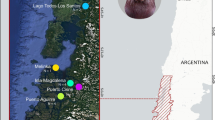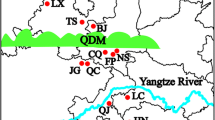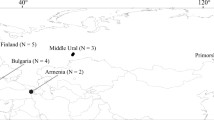Abstract
Major histocompatibility complex (MHC) is a family of highly polymorphic genes activating adaptive immunity in vertebrates. However, the underlying mechanism of MHC evolution is still not fully understood. In this study, we investigated genetic variation of three classical MHC class I genes in the giant panda (Ailuropoda melanoleuca) and tested for selection effect and recombination event across exonic and intronic sequences to understand maintenance mechanism of polymorphism at Aime-MHC class I genes. In total, we isolated 21 MHC class I haplotypes (exon 2–intron 2–exon 3) from 46 captive giant pandas, of which eight were for Aime-C, seven for Aime-I and six for Aime-L; however, we only identified six unique sequences from these haplotypes. The subsequent maximum-likelihood and Chi-square analyses both detected evidence of recombination acting on the 21 haplotypes. These results indicate that the giant panda still retains a relatively high adaptive variation at Aime-MHC-I genes, and that the intronic segments have been homogenized along evolutionary time by recombination and subsequent genetic drift. We calculated nucleotide substitution rates of the antigen-binding regions (exons 2 and 3) and the noncoding intron 2, and found two pieces of evidence supporting the presence of balancing selection in the giant panda: an excess of nonsynonymous over synonymous substitutions at the antigen-binding sites, and an obviously higher synonymous substitutions in the exons than nucleotide substitutions in the intron. Thus, this study reveals that balancing selection and recombination together shape the diversity pattern at Aime-MHC-I loci of the giant panda.
摘要
Major histocompatibility complex (MHC)是脊椎动物免疫系统中负责抗原呈递的基因家族,其多态性维持机制一直是学术界的研究热点。多种进化动力参与维持MHC的适应性多态,导致物种间的MHC多态性维持机制各有特色。本文通过检测大熊猫I类MHC的遗传变异,分析外显子和内含子区段的选择效应和重组事件,发现卧龙圈养大熊猫具有较高的环境生存能力,同时揭示平衡选择和重组作用共同驱动大熊猫I类MHC基因的变异能力。

Similar content being viewed by others
References
Piertney SB, Oliver MK (2006) Heredity 96:7–21
Schaschl H, Wandeler P, Suchentrunk F et al (2006) Heredity 97:427–437
Miller HC, Allendorf F, Daugherty CH (2010) Mol Ecol 19:3894–3908
Steiner N, Baldassarre L, Koester R et al (2002) Tissue Antigens 59:148–150
Zhu Y, Wan QH, Yu B et al (2013) BMC Evol Biol 13:227
Allendorf FW (1986) Zoo Biol 5:181–190
Anisimova M, Nielsen R, Yang Z (2003) Genetics 164:1229–1236
Spurgin LG, Richardson DS (2010) Proc Roy Soc Lond B Biol Sci 277:979–988
Hughes AL, Yeager M (1998) Annu Rev Genet 32:415–435
Acknowledgments
This work was supported by a special grant (SG1411) for the giant panda from the State Forestry Administration of China.
Conflict of interest
The authors declare that they have no conflict of interest.
Author information
Authors and Affiliations
Corresponding author
Electronic supplementary material
Below is the link to the electronic supplementary material.
About this article
Cite this article
Yu, FJ., Zhu, Y., Xiong, TY. et al. Balancing selection and recombination drive genetic variation at MHC class I genes in the giant panda. Sci. Bull. 60, 136–138 (2015). https://doi.org/10.1007/s11434-014-0686-7
Received:
Accepted:
Published:
Issue Date:
DOI: https://doi.org/10.1007/s11434-014-0686-7




